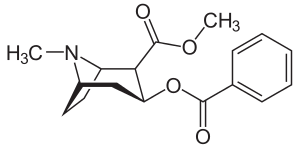Biosynthesis of cocaine

The biosynthesis of cocaine has long attracted the attention of biochemists and organic chemists. This interest is partly motivated by the strong physiological effects of cocaine, but a further incentive was the unusual bicyclic structure of the molecule. The biosynthesis can be viewed as occurring in two phases, one phase leading to the N-methylpyrrolinium ring, which is preserved in the final product. The second phase incorporates a C4 unit with formation of the bicyclic tropane core.[1]
Biosynthesis of N-methyl-pyrrolinium cation
The biosynthesis begins with L-glutamine, which is derived from L-ornithine in plants. The roles of L-ornithine and L-arginine was confirmed by Edward Leete.[2] Ornithine then undergoes a PLP-dependent decarboxylation to form putrescine. In animals, however, the urea cycle derives putrescine from ornithine. L-Ornithine is converted to L-arginine,[3] which is then decarboxylated via PLP to form agmatine. Hydrolysis of the imine derives N-carbamoylputrescine followed with hydrolysis of the urea to form putrescine. The separate pathways of converting ornithine to putrescine in plants and animals have converged. A SAM-dependent N-methylation of putrescine gives the N-methylputrescine, which then undergoes oxidative deamination by the action of diamine oxidase to yield the aminoaldehyde, which spontaneously cyclizes to N-methyl-Δ1-pyrrolinium cation.

Beyond its role in cocaine, the N-methyl-pyrrolinium cation is a precursor to nicotine, hygrine, cuscohygrine, and other natural products.[1]
Conversion of N-methyl-pyrrolinium cation to the tropane
The additional carbon atoms required for the synthesis of cocaine are derived from acetyl-CoA, by addition of two acetyl-CoA units to the N-methyl-Δ1-pyrrolinium cation.

Chemical synthesis
The synthesis and structure elucidation of cocaine was reported by
References
- ^ PMID 2236285.
- S2CID 4264282.
- S2CID 45912704.
- ISBN 978-0-470-74276-1.
- .
- PMID 10814231.
- .
- .
- PMID 11699882.
- ISBN 978-3-540-66573-1.
